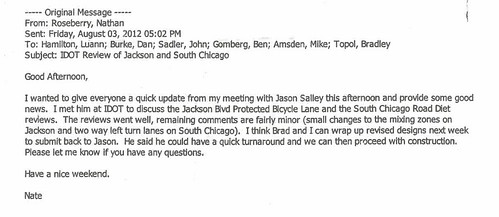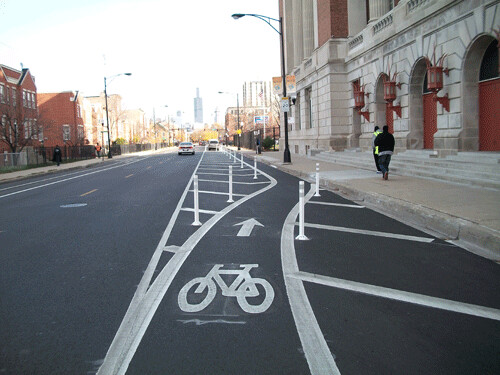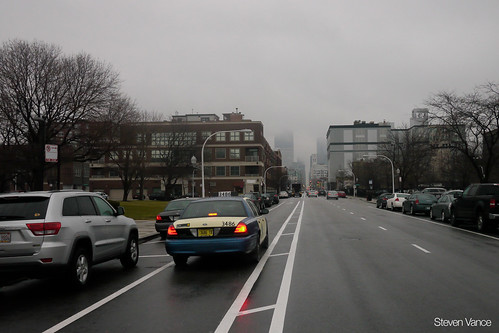The Illinois Department of Transportation’s ban on protected bicycle lanes on state-jurisdiction roads is a mystery. As Steven Vance reported in February of this year, the department is prohibiting the Chicago Department of Transportation from installing PBLs on IDOT streets at least until CDOT provides three years of “safety data” on existing protected lanes. Since the city’s first protected lanes on Kinzie Street opened in July 2012, that means CDOT won’t be able to install PBLs on these streets for a year at the very least.
IDOT’s illogical policy is preventing streets from becoming safer. For example, CDOT has designated Clybourn Avenue, where cyclist Bobby Cann was killed by an allegedly drunk, speeding driver on May 29, as a bike-priority Crosstown Bike Route, and the street is wide enough for protected bike lanes. However, due to the ban, the city has no choice but to instead stripe buffered bike lanes, mere paint on the road, which offers zero physical protection from reckless motorists.
Ironically, officials from IDOT and the governor’s office have claimed that the transportation department wants to be certain that PBLs are safe before they allow Chicago to install them on state roads. “There are reasons why IDOT requires a certain amount of time to do studies,” David Blanchette, spokesman for Governor Pat Quinn, told me earlier this week, assuring me that our bike-friendly governor is in the loop about the ban. “[IDOT has] certain time frames that they like to observe on studies of this kind because they want to make sure the safety of pedestrians, bicyclists and motorists isn’t shortchanged.”
This argument rings false, since protected lanes have been the standard for decades in Europe’s safest cycling cities, and the lanes have been proven to decrease crashes for all road users in peer American cities like New York, which has been installing them since 2007. Blanchette responded that Chicago is a unique city with a unique situation, but that strikes me as a rationalization for a state transportation department that simply does not want to allow PBLs on its streets.
Perhaps IDOT is opposed to the conversion of excess travel lanes or car parking to make room for protected lanes, or maybe there is a hidden political motivation for the ban. Whatever the state’s true reasons are for blocking Chicago from installing PBLs, an email recently obtained from CDOT provides evidence that safety isn’t one of them.
After Streetsblog broke the news about the prohibition, we reached an agreement with the Active Transportation Alliance to share any information gained about the ban. The email, which Active Trans acquired from CDOT via a Freedom of Information Act request, refers to Chicago’s Jackson Boulevard, where the city planned to install a protected lane on a two-mile stretch between Western Avenue and Halsted Street. CDOT built the PBL from Western to Ogden Avenue in October of 2011. However, no work was done on the eastern portion from Ogden to Halsted. As Steven later learned, the reason for the gap was because this section of Jackson is under IDOT jurisdiction.
In the email, dated August 3, 2012, CDOT Bikeways Engineer Nathan Roseberry informed other city transportation staff that he met with IDOT Engineer Jason Salley that morning to discuss CDOT’s plans for protected lanes on the state-jurisdiction portion of Jackson. Roseberry wrote that IDOT approval of the PBLs was imminent:
The reviews went well, remaining comments are fairly minor (small changes to the mixing zones on Jackson ... ) I think [CDOT Bikeways Engineer Brad Topol] and I can wrap up designs next week and submit back to Jason. He said we could have a quick turnaround and then proceed with construction.
However, the construction delay continued for several more months. Finally, in January of this year, 15 months after work on Jackson started, CDOT completed the eastern portion, striping buffered lanes instead of protected lanes. The following month, Steven reported that the reason for the downgrade was the IDOT ban.
Roseberry’s email shows that IDOT officials originally had no problem with PBLs on state roads and were not concerned that the lanes were unsafe. However, sometime between August 3, 2011, and January of 2012, someone at the state decided to block PBLs on IDOT streets, for reasons that apparently had nothing to do with safety. Streetsblog recently submitted a FOIA request to the state in order to find out who that person is.







